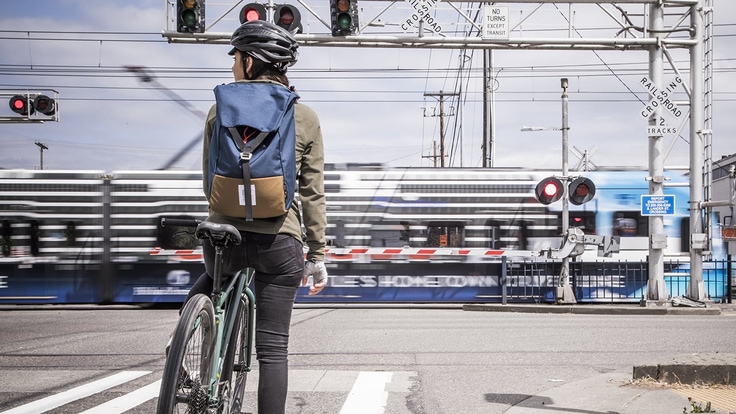Sharing the road with cars, SUVs and trucks is a fact of cycling life. Legally, bicycles have all of the same rights and responsibilities that automobiles do, yet too often cyclists are viewed as the second-class citizens of the road.
Cyclists are expected to follow all of the same traffic laws as motorists, yet must mingle with larger, faster vehicles (and the sometimes impatient people who steer them). Here are our street-smart guidelines for becoming a wiser, safer cyclist.
Basic Rules of the Road
Bike Safety Fundamentals
- Wear a helmet on every ride.
- Wear bright, highly visible clothing, preferably with reflective tape or patches.
- Obey the rules of the road. Stop at stop signs and lights.
- Ride with the flow of traffic, not against it.
- Ride in control at all times. Proceed at a safe speed that permits you to react quickly to unexpected circumstances.
- Yield to pedestrians and other vehicles.
- Never ride in low-light or dark conditions without front and rear bike lights and reflectors.
Riding Technique
- Keep a safe distance between yourself and other riders or vehicles. What qualifies as safe? Enough space to allow you to react to something unexpected. In general, aim for 1 bike length (or more) per each 5 miles per hour you're traveling. Keep at least 4 feet between you and a vehicle.
- Don't hug the curb too closely. Maintain a comfortable distance from the pavement edge.
- Ride in single file. This is required by law in most states. (Note: Some states allow cyclists to travel 2 abreast. Do this only on less-traveled roads that are free of traffic. Riding 3 abreast is usually illegal.)
- Don't ride on sidewalks unless no other safe option exists. Motorists at intersections or when leaving or entering driveways often do not see swift-moving cyclists traveling on sidewalks.
- Likewise, watch for cars coming out of alleys. They may not see you.
- Don't pass other cyclists on the right.
- When needed, make noise—use a horn, a bell, whistle or just yell.
- In heavy, slow-moving traffic, it's often safer to ride in the middle of a traffic lane so that everyone can see you and cars won't try to squeeze around you.
- On busy streets, don't swerve back and forth around parked cars or other obstacles. Maintain a straight course and watch out for opening car doors.
- Be ready to brake. Keep your hands on or near the brake levers so you can stop quickly.
- Pedal strongly when going through intersections.
- If 5 or more cars are behind you, pull over and let them pass.
- Be predictable.
Road Awareness
- Stay alert to changes in your surroundings at all times.
- Communicate your intentions to drivers and other cyclists as much as possible. Use hand signals whenever you turn or stop, but assume that those signals might not be understood by every driver. Watch our video on using hand signals.
- Make friendly eye contact with drivers. This helps to ensure your intentions are understood by motorists.
- Semi-trucks have a blind spot when they turn; avoid riding in the blind spot.
- Watch out for things that can add to (or cause) problems between cyclists and automobiles, like bright sunlight, fatigue, darkness and sharp bends in the road.
- Avoid actions that can cause accidents between bicycles, such as following too closely, poor communication or lapses in concentration.
- Be especially cautious at intersections. Many cycling accidents occur here.
- Ride with confidence when you're in traffic. Timid, wobbly riders make drivers nervous. Cyclists or groups of cyclists who ride in a respectful, self-assured manner are more likely to be granted extra room and respect in return.
Video: Hand Signals for Cyclists
Highway Riding
Cycling on high-speed roads requires extra caution. Avoid it if you can, but if you must, follow these rules:
- Stay as far right as you can, using the paved shoulder whenever possible.
- Check behind yourself frequently and listen for approaching cars. To make this easier, wear a helmet-mounted or eyeglass-mounted mirror.
- Brace yourself for passing vehicles (especially large trucks or other wide vehicles) by gripping your handlebars firmly, lowering your body to lessen wind resistance and moving as far to the right as possible.
- Keep in mind that the wind from passing vehicles tends to "pull" cyclists forward and toward the passing vehicle.
Reminder: Just because you're on a bike, it doesn't mean that you can't be cited for a traffic violation. Follow the rules of the road.



